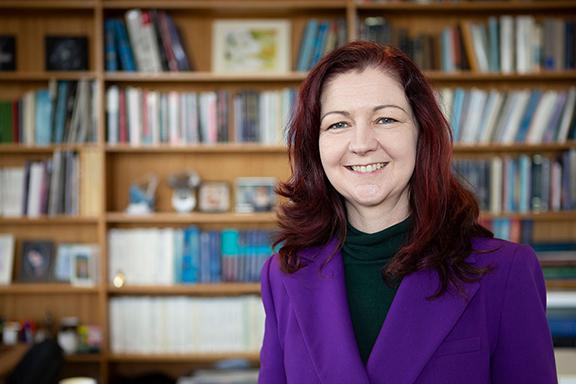ASTRO 3D achieved gender parity in astronomy in just five years all while continuing to study how the Universe evolved, how galaxies form and where the elements come from.

Professor Lisa Kewley, founding Director of ASTRO 3D, current Director of the Center for Astrophysics, Harvard & Smithsonian.
Cambridge, MA – Around the world, research agencies are struggling to achieve gender parity.
A paper published in Nature Astronomy today reports how the national Australian astronomy center ASTRO 3D, led at the time by Professor Lisa Kewley, now director of the Center for Astrophysics | Harvard & Smithsonian (CfA), achieved equal numbers of women and men using scientific strategies.
"We used research in sociology and psychology to develop evidence-based recruitment and retention initiatives and to create a supportive and positive culture in our Center," says Prof. Kewley, the founding director of ASTRO 3D, the Australian Research Council center for All Sky Astrophysics in 3 Dimensions, and the lead author on the paper.
"Our success offers a model to other organizations, especially in the physical sciences where participation rates for women continue to be well behind the biological sciences, and where gender equality has remained stubbornly low," says Professor Emma Ryan-Weber, the current Director of ASTRO 3D.
"Astronomy is a gateway science," says Prof. Ryan-Weber. "Students are fascinated by the question of what’s out there in space. I am proud that our center is providing a diverse range of role models for the next generation."
"Astronomy is regarded as leading in gender equity in the physical sciences. But when we established ASTRO 3D in 2017, I looked at the numbers, and calculated that based on current trends, it would take more than 60 years to reach gender parity," says Prof. Kewley.
Across Australia, women make up 30 – 35% of PhD astronomy students, and less than 20% at the highest professorial level. "And women are more than three times more likely to leave the profession in Australia, where 62% of women and 17% of men leave Australian astronomy at the junior postdoctoral levels. We had to do better," Prof. Kewley says.
"Our program was implemented between December 2017 and June 2023. In that time ASTRO 3D went from 38% women to 50%," she says.
- setting diversity targets with regular monitoring of progress,
- selecting diverse set of team leaders,
- in-person diversity training for all organization members,
- ensuring 50% women on postdoctoral selection committees, and
- ensuring 50% women on postdoctoral short-lists.
Diverse leadership is crucial for improving the diversity within teams," says Professor Stuart Wyithe, Director of the Research School for Astronomy & Astrophysics, the Australian National University and co-author of the paper.
"Women-led teams recruited and retained more women postdoctoral researchers, attracted more women students, and worked with more women collaborators, while the converse was true for men-led teams," he says.
"The ASTRO 3D program reached a tipping point when there were 40% women in the organization as supervisors, mentors and role models for students. After that, student enrolments by women in the center accelerated. The gains were not made at the expense of men, as the membership grew over this period," Prof. Kewley says.
Recruiting women is one thing but retaining them is just as important and ASTRO 3D introduced a range of policies to make sure their staff felt welcome and valued. These included a focus on leadership development, promotion of work-life balance, partner recruitment, as well as pathways for reporting misconduct.
In all categories, larger percentages of women were retained than men.
Among students, 55 – 58% women were retained compared with 37 – 48% men and a larger percentage of women postdoctoral researchers were retained in the center (67 – 70% women and 55 – 69% men).
"This suggests that the presence of women supervisors and role models is critical for attracting and retaining women."
Prof. Ryan-Weber says the paper clearly paves the way for other research centers to achieve similar results.
"Our researchers have made phenomenal discoveries in understanding how elements, stars, galaxies and the gas that surrounds them evolved from the early Universe to today. Their skills have translated to international success in academia and to solve real-world problems in industry."
"But the greatest legacy of ASTRO 3D may be as a role model for better diversity in research," she says.
The paper describing the results by Kewley's team appears in Nature Astronomy, and a preprint is available online. In addition to those listed above, the authors include Kim-Vy Tran (CfA) and Ingrid McCarthy (Australian National University and ASTRO 3D).
This text was adapted from a press release by Science in Public.
###
About ASTRO 3D
The ARC Centre of Excellence for All Sky Astrophysics in 3 Dimensions (ASTRO 3D) is a $40 million Research Centre of Excellence funded by the Australian Research Council (ARC) and nine collaborating Australian universities – The Australian National University, The University of Sydney, The University of Melbourne, Swinburne University of Technology, The University of Western Australia, Curtin University, Macquarie University, The University of New South Wales, and Monash University.
About the Center for Astrophysics | Harvard & Smithsonian
The Center for Astrophysics | Harvard & Smithsonian is a collaboration between Harvard and the Smithsonian designed to ask—and ultimately answer—humanity's greatest unresolved questions about the nature of the universe. The Center for Astrophysics is headquartered in Cambridge, MA, with research facilities across the U.S. and around the world.
Media Contact:
Mercedes López-Morales
Acting Associate Director for Science
Center for Astrophysics | Harvard & Smithsonian
+1 617 496 7818
mlopez-morales@cfa.harvard.edu